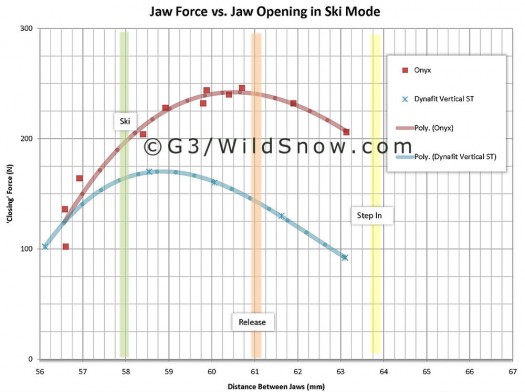G3 sent this info over. Their engineer did some testing on production bindings, Onyx and Dynafit Vertical ST. This should interest any binding geeks out there, but especially those who might have trouble staying in Dynafit bindings and feeling compelled to ski them with the touring lock engaged.
Note, I’m getting a sore throat from repeating that the vast majority of skiers have no trouble skiing Dynafit bindings in alpine mode WITHOUT locking out their release, so don’t get all hot under the boot soles about this. But randonnee binding retention and pre-release are still issues that do affect bigger, stronger skiers on heavy gear (usually on harder snow) so we feel it is fair to keep bringing it up and sharing information such as this.
According to the G3 engineer, who I have no reason to doubt since our own tests show an obvious difference between the bindings (following is paraphrased): “The obvious difference in jaw pressure is not only due to the springs we use, but more so due to the geometry of the jaw arms and their pivot points. You can see that a Dynafit binding goes “overcentre” (pops open) at around ~63mm (in order to be able to be not too wide when fully opened). The G3 toe goes overcentre at around 67mm (which is a range that the toe never really gets to). This is one of the reasons why you have to open the G3 toe.”
The graph highlights 3 key jaw widths (defined as distance between the toe pin tips):
· Ski ~58mm – which is the width that the pins are at when you’re engaged in the binding, this is dictated by the standardized (we pray) boot fitting
· Release ~61mm – the approximate width that Onyx and Dynafit release occurs at (meaning the boot tech fitting easily disengages from the binding toe pins)
· Step in – ~64mm for the onyx… Dynafit measures at 66mm for the various ST models we have in the WildSnow shop
According to G3 engineer: “You can see from the curves between ski and release that the area below the curves (which is energy absorbed) is much larger for the Onyx. In the opinion of G3, this is why people can ski the onyx much harder in icy conditions without locking the toe out. We did this testing with an instron type pull tester equipped with an LVDT displacement transducer, so I’m very confident in our results.”
N = Newtons, the metric unit of force (1 pound = 4.45 Newtons)
mm = millimeters for displacement ( 1 inch = 25.4 mm)
WildSnow.com publisher emeritus and founder Lou (Louis Dawson) has a 50+ years career in climbing, backcountry skiing and ski mountaineering. He was the first person in history to ski down all 54 Colorado 14,000-foot peaks, has authored numerous books about about backcountry skiing, and has skied from the summit of Denali in Alaska, North America’s highest mountain.

